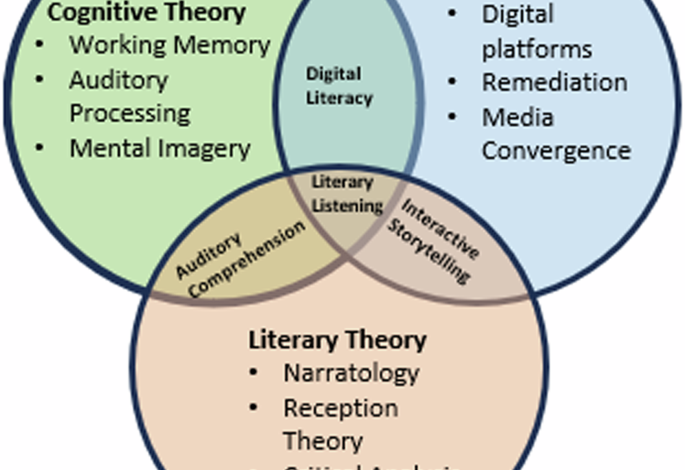The listening renaissance: a theoretical exploration of audio-based digital narratives in literature

The historical background provides a foundation for understanding the development of audio-based digital narratives, the technological factors that have shaped their evolution, and the cultural shifts that have accompanied their rise. It sets the stage for a deeper exploration of how these changes affect the engagement with literature in the digital age.
The evolution of audio literature
The roots of audio literature can be traced back to the early 20th century, with the advent of radio plays. One of the most famous early examples is Orson Welles’ broadcast of “The War of the Worlds” which demonstrated the power of audio storytelling to captivate audiences (Schwartz, 2015). The concept of recorded books for the blind emerged in the 1930s, with the American Foundation for the Blind creating the “Talking Book” program. This initiative used vinyl records to provide access to literature for visually impaired individuals (Rubery, 2016).
The 1950s and 1960s saw the introduction of audiobooks on vinyl records and cassette tapes, making them more widely available to the general public. Companies like Caedmon Records, founded in 1952, began producing spoken word recordings of authors reading their works, including Dylan Thomas and T.S. Eliot (Rubery, 2016). The digital revolution of the late 20th century transformed audio literature. The launch of Audible.com in 1995 marked a significant milestone, introducing downloadable digital audiobooks and changing the landscape of audio literature distribution (Have and Pedersen, 2015). The 2000s saw the rise of podcasting, which further expanded the audio narrative landscape. Podcasts offered new formats for storytelling, literary discussion, and serialized fiction. Shows like “Serial” (2014) demonstrated the potential for audio narratives to reach massive audiences and influence popular culture (McHugh, 2016).
Technological advancements and their impact
The progression of audio literature has been closely tied to technological advancements. The transition from analog (vinyl and cassettes) to digital formats (CDs, MP3s, and streaming) dramatically improved sound quality, portability and accessibility. The introduction of portable MP3 players in the late 1990s, epitomized by the iPod in 2001, revolutionized how people consumed audio content, including audiobooks. These devices allowed users to carry entire libraries in their pockets (Sterne, 2012).
Smartphones and dedicated e-readers with audio capabilities further enhanced the convenience of consuming audio literature. The integration of audiobook apps with cloud technology allowed for seamless listening across multiple devices (Singh and Alexander, 2022). Streaming services and AI-driven recommendations have revolutionized how users discover and access audio content. Platforms like Audible, Scribd, and Spotify have invested heavily in audiobook and podcast content, making it easier than ever for users to find and consume audio literature (Geerling, 2023).
Text-to-speech technology has expanded the availability of audio content, though it raises questions about the role of human narration in the listening experience. While this technology has made more texts accessible in audio format, many listeners still prefer human narration for its emotional nuance and interpretive quality (Larson, 2015).
Global market expansion and economic dimensions
The digital audio literature landscape has experienced exponential growth across global markets, transforming not just technological consumption but also the economic infrastructure of publishing. The market expansion reveals a nuanced global narrative of audiobook adoption.
In the United States, the market demonstrates particularly robust growth. The Audio Publishers Association reported a 25% revenue increase in 2021, reaching $1.6 billion, with digital platforms driving unprecedented expansion. The demographic breakdown is revealing: 53% of audiobook listeners are under 45, with women representing 56% of the market. Critically, the average listener consumes 8.1 books annually, indicating deep engagement beyond mere novelty (Anderson, 2022).
Recent data from Bookwire report (2024) provides additional insights into the Spanish-language segment of this market. The Spanish-language audiobook sector experienced a remarkable 45.7% growth in revenue in 2023, following a 52.81% increase in 2022. The available catalog has expanded significantly, growing from 8,000 titles in 2018 to 20,100 titles in 2023, with projections reaching 24,120 titles by 2024. The United States has emerged as a leader in Spanish-language audiobook growth specifically, showing a 67% increase over the previous year, while Spain follows with 55% growth. Latin America and Mexico show more modest growth at 19% and 2% respectively.
Nordic countries have shown even more dramatic market transformations. Sweden experienced a remarkable 38% increase in audiobook consumption between 2019 and 2022. Denmark followed closely, with a 35% market growth and digital platforms accounting for nearly 60% of audio content consumption. Norway mirrored this trend, with ~40% market expansion and strong integration of audiobooks in educational and professional contexts (Bookwire, 2024).
The market structure varies significantly by region. In the United States, non-fiction audiobooks dominate with 67% of the market share, compared to 33% for fiction. This contrasts with Spain, where fiction leads with 56% of the market. Subscription models have become the primary revenue stream, accounting for 85.93% of total audiobook sales in 2023 (Bookwire, 2024). This trend is further supported by platforms like Spotify, which has launched limited hourly subscription plans in English-speaking countries and secured agreements with major publishers to expand audiobook access.
Emerging markets present equally compelling developments. Mexico has witnessed a 22–25% growth in audiobook consumption, driven by increasing digital literacy and smartphone penetration (Bookwire, 2024). This growth reflects a broader global trend of shifting literary consumption patterns, where audio formats are transitioning from niche to mainstream.
Karl Berglund’s seminal work, “Reading Audio Readers”, provides critical insights into these emerging consumption patterns. Berglund (2024) argues that audiobook platforms are not merely technological innovations but represent a fundamental restructuring of publishing business models. The shift towards streaming-based audio literature consumption challenges traditional publishing hierarchies, democratizing both content creation and distribution.
The economic implications extend beyond direct sales. Streaming platforms like Audible, Scribd, and emerging regional services have developed sophisticated algorithmic recommendation systems, transforming how listeners discover and consume literary content. These platforms are not just distribution channels but active curators of literary experiences, influencing reading (or listening) behaviors on an unprecedented scale.
Cultural shifts in literature consumption
The rise of audio literature reflects broader cultural shifts in how individuals consume media and literature. The increasing pace of modern life has led to a demand for content that can be consumed while multitasking. Audiobooks and podcasts allow people to engage with literature while commuting, exercising or doing household chores (Have and Pedersen, 2015). There’s been a resurgence of interest in oral storytelling traditions, with audio formats providing a modern avenue for this age-old practice. This trend connects to primal instincts for oral communication and storytelling, giving a new dimension to literary experiences (Wittkower, 2011). The growth of audio literature has intersected with movements towards greater accessibility in media. Audiobooks provide alternative ways to engage with literature for those with visual impairments, reading difficulties like dyslexia or other conditions that make traditional reading challenging (Moyer, 2012).
The digital age has also seen a shift towards more immersive and interactive storytelling experiences. Some audio narratives now include sound effects, multiple voice actors and even interactive elements, blurring the lines between traditional audiobooks, radio dramas, and video games (Alexander, 2017). Lastly, the rise of user-generated content and self-publishing platforms has democratized the creation and distribution of audio literature. This has led to a more diverse range of voices and stories being shared through audio formats, challenging traditional gatekeepers in the publishing industry (Spinelli and Dann, 2019).
Source link

